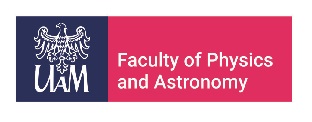| 2. | Sara Memarzadeh, Mateusz Gołębiewski, Maciej Krawczyk, Jarosław W. Kłos Nucleation and arrangement of Abrikosov vortices in hybrid superconductor–ferromagnet nanostructures Nanoscale Horiz., 10 , pp. 1453 - 1464, 2025. Abstract | Links | BibTeX @article{D4NH00618F,
title = {Nucleation and arrangement of Abrikosov vortices in hybrid superconductor–ferromagnet nanostructures},
author = {Sara Memarzadeh and Mateusz Gołębiewski and Maciej Krawczyk and Jarosław W. Kłos},
url = {http://dx.doi.org/10.1039/D4NH00618F},
doi = {10.1039/D4NH00618F},
year = {2025},
date = {2025-05-21},
journal = {Nanoscale Horiz.},
volume = {10},
pages = {1453 - 1464},
publisher = {The Royal Society of Chemistry},
abstract = {This study investigates the nucleation, dynamics, and stationary configurations of Abrikosov vortices in hybrid superconductor–ferromagnet nanostructures subjected to inhomogeneous magnetic fields generated by a ferromagnetic nanodot. Employing the simulations based on time-dependent Ginzburg–Landau coupled with Maxwell's equations, we reveal the evolution of curved vortex structures that exhibit creep-like deformation before stabilizing. The interplay between vortices and currents confined within the superconducting nanoelement gives rise to unconventional stationary vortex arrangements, which evolve gradually with increasing magnetic field strength—a behavior absent in homogeneous fields. Our numerical results illustrate how the ferromagnetic element can control vortex configurations via a stray magnetic field—insights that are difficult to access experimentally or analytically. We demonstrate that the superconducting nanoelement can stabilize into distinct vortex states in response to even small system perturbations. This highlights the extreme sensitivity of the system and the richness of its dynamic behaviour, revealing complex pinning mechanisms and providing valuable insights into the optimisation of nanoscale superconducting systems.},
keywords = {},
pubstate = {published},
tppubtype = {article}
}
This study investigates the nucleation, dynamics, and stationary configurations of Abrikosov vortices in hybrid superconductor–ferromagnet nanostructures subjected to inhomogeneous magnetic fields generated by a ferromagnetic nanodot. Employing the simulations based on time-dependent Ginzburg–Landau coupled with Maxwell's equations, we reveal the evolution of curved vortex structures that exhibit creep-like deformation before stabilizing. The interplay between vortices and currents confined within the superconducting nanoelement gives rise to unconventional stationary vortex arrangements, which evolve gradually with increasing magnetic field strength—a behavior absent in homogeneous fields. Our numerical results illustrate how the ferromagnetic element can control vortex configurations via a stray magnetic field—insights that are difficult to access experimentally or analytically. We demonstrate that the superconducting nanoelement can stabilize into distinct vortex states in response to even small system perturbations. This highlights the extreme sensitivity of the system and the richness of its dynamic behaviour, revealing complex pinning mechanisms and providing valuable insights into the optimisation of nanoscale superconducting systems. |
| 1. | Yulia Kharlan, Krzysztof Sobucki, Krzysztof Szulc, Sara Memarzadeh, Jarosław W. Kłos Spin-wave confinement in a hybrid superconductor-ferrimagnet nanostructure Phys. Rev. Appl., 21 , pp. 064007, 2024. Abstract | Links | BibTeX @article{PhysRevApplied.21.064007,
title = {Spin-wave confinement in a hybrid superconductor-ferrimagnet nanostructure},
author = {Yulia Kharlan and Krzysztof Sobucki and Krzysztof Szulc and Sara Memarzadeh and Jarosław W. Kłos},
url = {https://link.aps.org/doi/10.1103/PhysRevApplied.21.064007},
doi = {10.1103/PhysRevApplied.21.064007},
year = {2024},
date = {2024-06-05},
journal = {Phys. Rev. Appl.},
volume = {21},
pages = {064007},
publisher = {American Physical Society},
abstract = {Eddy currents in a superconductor shield the magnetic field in its interior and are responsible for the formation of a magnetic stray field outside of the superconducting structure. The stray field can be controlled by the external magnetic field and affect the magnetization dynamics in the magnetic system placed in its range. In the case of a hybrid system consisting of a superconducting strip placed over a magnetic layer, we theoretically predict the confinement of spin waves in the well of the static stray field. The number of bound states and their frequencies can be controlled by an external magnetic field. We present the results of semianalytical calculations complemented by numerical modeling.},
keywords = {},
pubstate = {published},
tppubtype = {article}
}
Eddy currents in a superconductor shield the magnetic field in its interior and are responsible for the formation of a magnetic stray field outside of the superconducting structure. The stray field can be controlled by the external magnetic field and affect the magnetization dynamics in the magnetic system placed in its range. In the case of a hybrid system consisting of a superconducting strip placed over a magnetic layer, we theoretically predict the confinement of spin waves in the well of the static stray field. The number of bound states and their frequencies can be controlled by an external magnetic field. We present the results of semianalytical calculations complemented by numerical modeling. |


